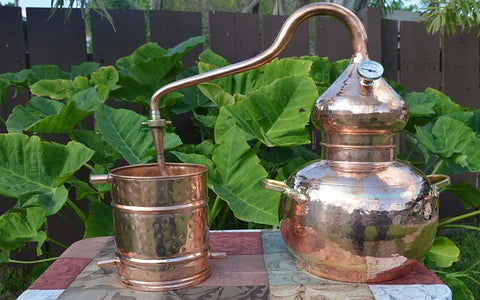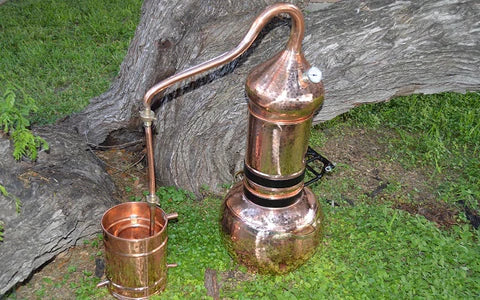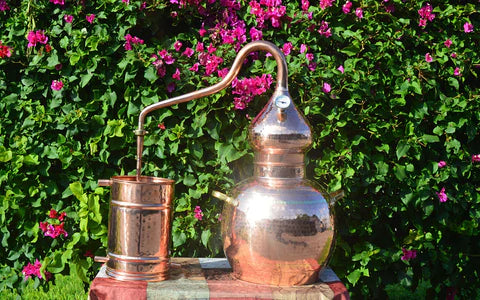What type of still should I use?
Distilling separates different plant materials using heat, water, and steam. It is a process of steaming what you want to distill, then cooling that steam back into a liquid and condensing it into a container. Distilling has been used throughout the centuries to purify water, to make different alcohols, and to refine plants for their essential oils. Because it is a process that has many uses, different types of stills have been developed to tackle these tasks.
Today, two of the most common still types are the pot still and the flip top column still.
What is the difference between a pot still and a flip top column still?
In short, the difference is the method with which each still uses steam to remove the desired material (the “distillate”) from the plants.
In a pot still the materials are placed directly in the water, which is boiled. The distillate travels with the steam, through the coil, and into the collection cup. This is the method of distilling usually used to make water and alcohols, although some types of essential oil are produced this way.
In a flip top column still the materials are placed in the column above the boiling water. As steam passes through the plants, they drip the distillate into the perforated platforms that attach to the column’s interior. At the top of the column, the steam condenses down the coil and into a collection cup. This is the method of distilling usually used to make essential oils and hydrosols - or “essence waters,” like “rose water” or “lavender water.”
The design of the flip top still makes it usable with the column attached to the pot and the onion head, or with the column rotated on the hinge so it is out of the way, and the onion head attached directly to the pot. Although this can make the flip top more versatile, it is also additional pieces to clean and maintain.
#1: The Pot Still

A pot still can be made of several different materials, but the best is a copper pot still. Because copper has antibacterial and antifungal properties, it will help to purify whatever you’re distilling - whether essential oils, alcohol, or water.
Parts of the still
The pot: A solid, round, enclosed tub which is placed over the heat source
The onion head: The narrowing bulb at the top of the pot, which resembles an onion
The condenser coil: The long copper tubing that attaches at the top of the onion head and slopes downward to an open spout
The collection cup: The container you place under the spout to catch your distillation. You can use metal, glass, or certain pottery, but you should never use plastic to collect distilled materials.
How to use a pot still
After thoroughly cleaning the parts of the copper still, you will place the pot over your heat source. (Always distill alcohol outdoors or in a well-ventilated area). You will pour the water, alcohol mash, or combination of water and plant materials into the pot. Assemble the onion head and condenser coil in place, sealing them with a flour paste mixture. Set up your cooling system for your condenser coil and get your collection cup in place. Turn on the heat and begin your distillation run. When the run is over, turn off the heat and allow all parts of the still to cool before disassembling and cleaning.
#2: The Flip Top Still

A flip top still can be made of several materials, but the best is copper. Because flip top stills are often used for essential oil distillation, the scent of the still’s material can be very important. Stainless steel stills may trap certain toxins and hold scents that taint the final essential oil. However, copper has antibacterial and antifungal properties, so it will help to purify the scents of the essential oils.
Parts of the still
The pot: A solid, round, enclosed tub which is placed over the heat source
The column: A cylindrical tube that is fixed to the top of the pot with an attached hinge. The top attaches to the onion head. Inside the column will be one or two levels of sieves, and one or two platforms with perforated holes, which allow steam to rise through the plants and the oil to drip down and collect on the platforms.
The onion head: The narrowing bulb at the top of the pot, which resembles an onion.
The condenser coil: The long copper tubing that attaches at the top of the onion head and slopes downward to an open spout.
The collection cup: The container you place under the spout to catch your distillation. You can use metal, glass, or certain pottery, but you should never use plastic to collect distilled materials.
How to use a flip top still
Thoroughly clean the parts of your copper flip top still, then set the pot over your heat source. (Consider distilling outside or in a well ventilated area for safety). Fill the pot 35-50% with water, and put the column in place. Pack your plant materials into the sieve or top platform, and don’t be shy about getting as much of it in there as you can.
Attach the onion top and condenser coil and seal the seams with a homemade flour paste, if necessary. Set up the cooling system for your condenser coil and put your steam-collection cup in place. This distilled, essence-infused steam becomes the hydrosol. Turn on your heat and begin your run. When the run is over, cut the heat and leave all copper still parts to cool before disassembling, collecting your oil, and cleaning.
Which still is better: pot still or flip top column still?
There is no real answer here - it depends on what you want to distill. If you think you will need a column occasionally but will use a pot still design most of the time, the flip top still design gives you that versatility. However, if you plan to only distill liquids that can be distilled in pot stills, the column on a flip top may just be unnecessary.
Whether you’re making spirits, purifying water, or creating essential oils, you should choose a copper still that suits your needs.
Article by: Jim Thomas



